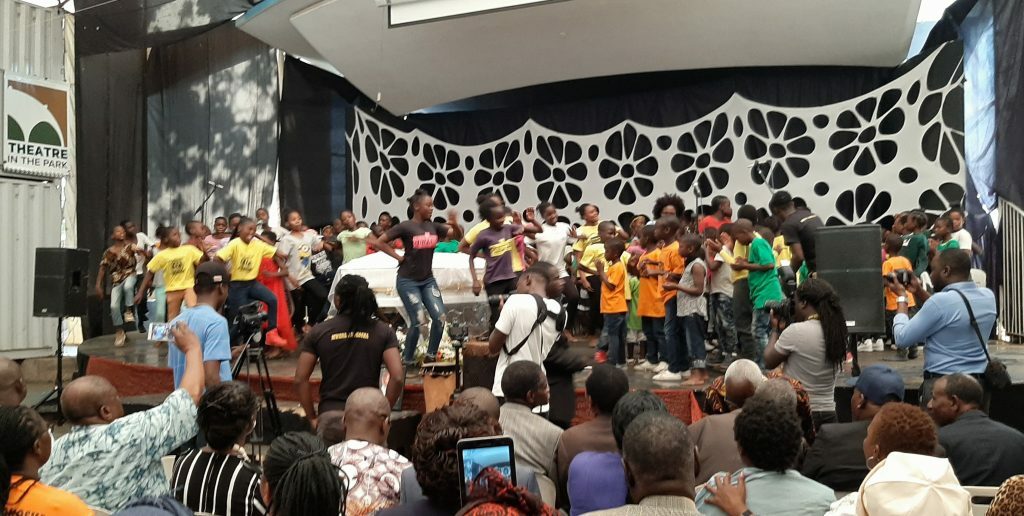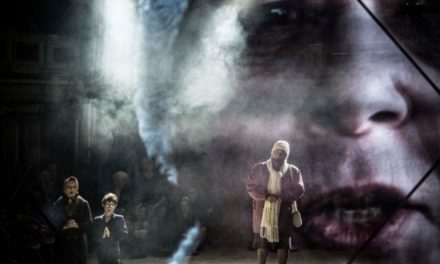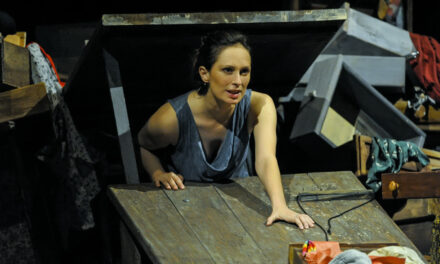Stephen Chifunyise’s death
At about 1830hrs on Monday, 5 August 2019, Stephen Joel Chifunyise breathed his last and died at his Vainona home in Harare, Zimbabwe. He was receiving home-based care after it was clear that he was losing his battle with cancer. It was on the same date that Toni Morrison, the renowned novelist, died and because of her geopolitical privilege, her death eclipsed that of Stephen Chifunyise on international news channels. Toni Morrison’s reputation in literary circles is comparable or arguably even exceeded by Stephen Chifunyise in theatre circles as will shortly become clear.
Born on 21 September 1948, Stephen Joel Chifunyise was 70 years of age and was only 46 days shy of his 71st birthday. It is possible that Chifunyise could have sensed that his death was near as plays he penned and performed between 2013 and 2015 dealt with disease, mourning and the spiritual realm which many Africans believe is the next phase of life. In 2013, Chifunyise penned Cancer in Our Blood (2013) which prefigured the disease that took his life. He also started thinking about the afterlife through his play, Taking Home a Spirit? (2013). The following year he wrote, Of course, You Need Help Fast (2014), which in hindsight spoke to the urgent medical help he needed. During the same year, he wrote, Please Mother, Don’t Cry for Me (2014). He could have imagined his family mourning his death.
Chifunyise interacted with many people and cared about them. He was described by his producer, Daves Guzha in a statement released to the media as “representing the best of whatever he had set his mind at yet remained humble, good-humored and accommodating regardless of who sought his counsel or friendship. Stephen (Chifunyise) was equally comfortable among artists whom he regarded as his peers”. Being a Shumba of the Sipambi clan (the lion of the Sipambi lineage) he lived and died like his totemic animal, the lion. He separated himself from his artistic family to fight this disease monitored by his nucleus family. He wanted to be remembered as a strong lion. On Thursday 8 August 2019, Chifunyise’s producers, Theatre in the Park, organized what they dubbed a “celebratory send-off service” where thousands of artists gathered to honor him in speeches and performances. The government of Zimbabwe honored him with a state-assisted funeral since he had worked for the government and advancing its cultural policies for several years. Many academics, artists and government officials attended the memorial service. Zambia, where Stephen Chifunyise worked and married until 1981 dispatched Professor Mwanza to deliver eulogies to honor his memory. Chifunyise was buried on Friday, 9 August 2019 at Greendale Cemetery in Harare, just after midday.
About his service to the theatre profession
Stephen Chifunyise’s career in theatre began in 1973 while he was still a student at the University of Zambia where he became national chairman of Zambia National Theatre Arts Association ZANTAA. Yet his ideas, theories, and practices on theatre have not been collected and analyzed for the benefit of future practitioners. Stephen Chifunyise was born in Nhema, Shurugwi in the Midlands province of the then Southern Rhodesia. He did his Sub A up to Standard 1 at St Linus Matoranjera School in Chitomborwizi, Chinhoyi. He moved to Shamweti Primary School, Mumbwa, Zambia in 1960 to do Standard 2, transferring to Chisengalumbwe from 1961 to 1964 to pursue Standard 3 up to 6. Between 1965 and 1969 he moved from Libala Secondary School to St Marks Secondary School to complete his high school education. The following year in 1970 he enrolled for his BA with education at the University of Zambia. After completing his studies he worked as a teacher at Matero Boys Secondary School between 1974 and 1975 where he had done his high school education. He went abroad to the USA where he successfully completed his MA in Theatre Arts in 1977 returning to Zambia the same year to take a post as drama lecturer at University of Zambia until 1979. In 1979, the Zambian government took him as the Director of Zambia Cultural Services and he left this job in 1981 to return to his newly liberated country, Zimbabwe. Stephen Chifunyise held various positions in the field of theatre. He was the director of Chikwakwa Theatre of UNZA (1977-1979), Secretary-General of International Theatre Institute, Zambia Centre (1977-1982), Secretary of National Music Industry Advisory Committee to the government of Zambia (1980-1982 and Vice President of the Union of African Performing Artists from 1983. It was during this time that Stephen Chifunyise developed his ideas on theatre which this article will partly explore.
When Zimbabwe attained her independence, Stephen Chifunyise returned back home and worked as Programme Producer at the Audio Visual Services in the Ministry of Education and Culture, leaving in 1983 to join the University of Zimbabwe as drama lecturer. He left after two months to re-join government as Chief Cultural Officer, rising to the positions of Director of Arts and Crafts (1983-1988), Deputy Secretary to the Vice President of Zimbabwe (1988-1995), Permanent Secretary Ministry of Sport, Recreation and Culture (1995-1997) and finally Permanent Secretary in the Ministry of Education and Culture 1997-2000). Stephen Chifunyise was at home in the vaunted environs of leading world bodies such as UNESCO where he worked as part-time art, culture and education consultant between 2000 and the time of his death. Here he advanced the culture, heritage and conventions and policies by conducting workshops and symposiums in many countries to promote them. As an educationist, he was principal of the Zimbabwe Academy of Arts Education for Development (ZAAED) between 2000 and the time of his death. He worked in the retail side of the arts as a General Manager of Kingstons Entertainment between 2004 and 2010, a chain store in Zimbabwe that sells books and music.
Chifunyise’s Dramatic Oeuvre
Although the Zimbabwean media puts Stephen Chifunyise’s creative output at more than 70 plays, this figure is too conservative given the evidence Chifunyise left with me. He shared a comprehensive professional CV with me 2 years before his death. The media statistics sometimes excludes the work that he developed while resident in Zambia and also the work beyond 2010 which his last updated CV does not capture. From 2014 when I moved to South Africa, Stephen Chifunyise made it a habit to send me his finished plays for review. I ran a review column in the Panorama online magazine and of course, I did a couple of reviews of his plays.
While in Zambia as a high school student at Matero Boys Secondary School and the time he left government employment in 1981, Chifunyise developed 18 works, 8 of which were television dramas beamed on Zambia Television between 1975 and 1978. 4 of these works ended up being published as stage plays in Chifunyise’s first published anthology, Medicine for love (1984), which has a collection of 4 plays. For this reason, Chifunyise’s long-time friend and South African/Zimbabwean academic, Robert Mshengu Kavanagh (aka McLaren) has described him “as a cultural giant, possibly more honored outside his country than within. Internationally and in Africa, Zambia, in particular, he looms large”. Claimed by both Zambia and Zimbabwe, the former dispatched Professor Mwanza who represented the Zambian cultural sector to come to Zimbabwe for Chifunyise’s funeral.
After a 3 year gestation period on his return to Zimbabwe, Chifunyise started writing for live performance in 1984 with his debut TV drama, Solo and Mutsai. Between 1984 and his last recorded play, Oh my grandfather (2015), Chifunyise wrote and staged 55 plays. I am not sure of the quantities produced between 2016 and 2019 when he died. Over and above these plays, Chifunyise published the following plays; Medicine for love (1984) [4 plays], Hungry children (1991), To love is to care (1995), Kubika mapoto/ Living in (1996), Tough choices (2007) [4 plays] and Intimate affairs (2008) [5 plays]. Excluding the last 5 plays which are listed on his professional CV, we can count 11 plays on the published list. The verifiable total now stands at 84 plays and since it is possible that he wrote more plays between 2016 and August 2019, I would put the total at slightly over 85 plays.
Chifunyise, the theoretician
Stephen Chifunyise’s academic papers which he contributed to the Tabex encyclopedia on Zimbabwe, Cambridge encyclopedia on theatre, world encyclopedia of contemporary performance and Southern Africa Journal on Culture do not articulate in any meaningful way his vision of a new Zimbabwean theatre. It is, however, in his speeches (as director of arts and crafts and later as permanent secretary in Zimbabwe’s ministry of education, sport and culture), newspaper articles and training manuals, that he clearly adumbrated the characteristics of what he called the new “national theatre”. Whereas during the colonial era theatre was clearly divided into binary oppositions – black theatre and white theatre (although there were a few exceptions) Chifunyise advocated for a non-racial culture in which “the themes of our national theatre should be non-racial” (1988, p. 40). According to Chifunyise (1986, 1988) in this new national theatre, the old colonial labels of black/white theatre and English/vernacular theatre were ridiculous and irrelevant. For this reason, Chifunyise deplored the practice of high art which accentuated racial divisions by creating theatre for an elite audience (mostly whites) dealing in imported themes. Chifunyise argued that this western theatre practice consolidated cultural imperialism (1986, 1988) and the government would intervene by withdrawing financial support.
Chifunyise and Kavanagh, his long-time friend, share an opposition to art for art’s sake and were believers in the functionality of theatre. Unlike theatre which celebrates the perfection of the form of the playwright’s craft and which deals with individuality and privatized themes such as Dambudzo Marechera (1984), Chifunyise and Kavanagh lobbied for a theatre that is politically engaged and is preoccupied with social and national problems with a Marxist-Leninist ideological inclination. They called this theatre “revolutionary theatre” (Chifunyise and Kavanagh (1988, p. 2) that is based on ‘a philosophy that is rooted strongly in socialism- a philosophy which dictates that theatre should be a tool for political and ideological development’ (Chifunyise 1986, p. 15).
The agency that Chifunyise, Kavanagh, wa Mirii and Gecau suggested should be given to peasant and proletarian characters was derived from Karl Marx’s ‘historical materialism’. Thus in the plays influenced by Chifunyise, it is the peasants and the workers who are the true creators of history through challenging their exploiters after first realizing that the status quo is unsustainable.
In terms of performance, Chifunyise proposed a post-independence non-Eurocentric aesthetic which utilized indigenous texts as its backbone. Chifunyise maintained that the performative idiom of national theatre must be based on “the people’s visual and performing arts which should become the major feature of their theatre” (Chifunyise 1986, p. 15). In other words, the cumulative use of indigenous partial texts should result in them becoming dominant in the theatre. Chifunyise was aware of the importance of western theatrical heritage and advocated for its use in unison with indigenous texts especially where theatre-making is structured around the concept of drama.
None of Chifunyise’s plays that were written and published in Zimbabwe demonstrates this theory exhaustively. It is in the plays of his colleagues and friends (wa Mirii, Kavanagh and Mujajati) that such a theory of performance is demonstrated. I asked Chifunyise if he preached what he could not practice and he indicated that his plays The Retired Ones (1979) and Mr. Polera (1978) (unpublished) which he wrote while still exiled in Zambia typified his performance theory. These plays were brought to Zimbabwe by Kanyama Theatre, a Zambian theatre company that Chifunyise worked with while in exile that ZACT hired in 1985 for a two month period to teach Zimbabwean artists by example. He further maintained that since 1971 when he started writing for the University of Zambia Dramatic Society (UZAMDRAMS) and Matero Boys Secondary School in 1973, he featured music and dance as the vehicle of dramatic structure in most of his plays. These include Mwaziona (n.d), Who Will Dance (n.d), Story of Mankind (n.d), The Slave Caravan (n.d) and Kachipapal (n.d) up to 1981. In Zimbabwe during the period 1980-1996 Chifunyise told me that he wrote plays that were performed by Glen Norah Women’s Theatre, Rooftop Promotions, People’s Theatre Company, Mount Pleasant High School, Alternative Savannah Theatre and Zvido Theatre Company, that includes Temporary Shelter (n.d), Farai (n.d) and My Piece of Land (n.d). All of them featured song and dance (Chifunyise 2011).
Chifunyise belonged to the second generation of African playwrights and theatre-makers. These were born between 1939 and 1959 and their artistic work began in the 1970s. None of the African peers compares to this record, making him the foremost playwright of his time. In the case of Zimbabwe, “he is, without doubt, the foremost Zimbabwean playwright now or in the past” (Kavanagh 2019).
This post was written by the author in their personal capacity.The opinions expressed in this article are the author’s own and do not reflect the view of The Theatre Times, their staff or collaborators.
This post was written by Samuel Ravengai.
The views expressed here belong to the author and do not necessarily reflect our views and opinions.


















